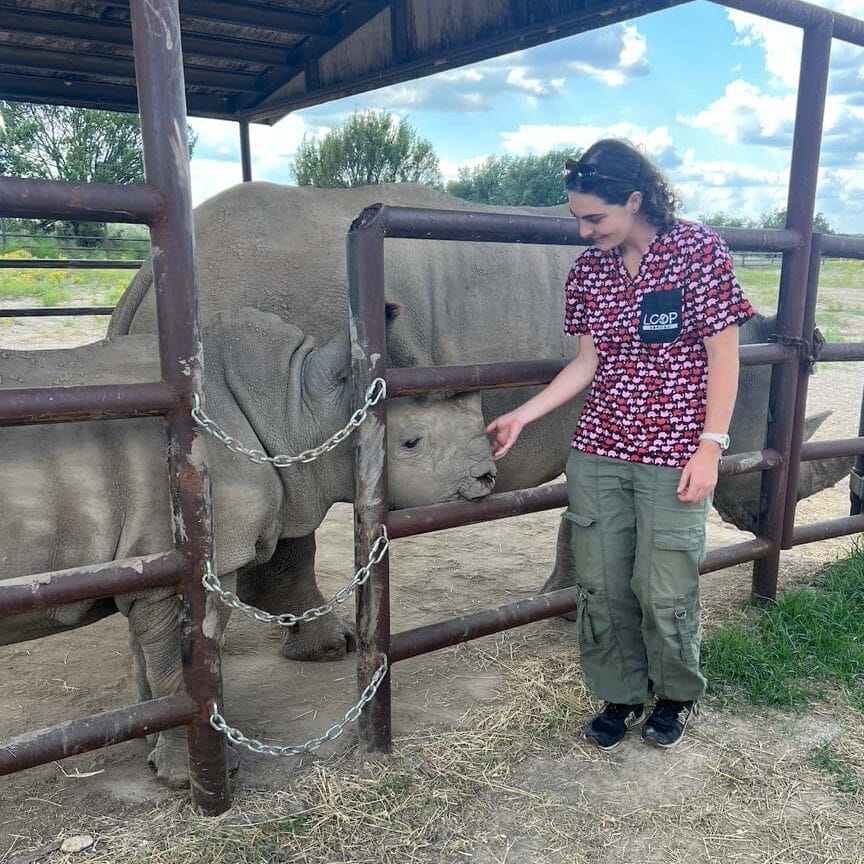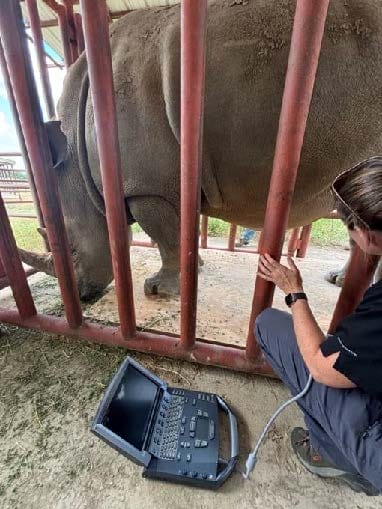My name is Sage Demopoulos, and I am in my final year of veterinary school at Cornell University College of Veterinary Medicine in Ithaca, New York. My lifelong ambition is to contribute to the field of conservation which consists of not only caring for individual animals but contributing to One Health (the relationship among animals, the environment, and people) to better the lives of all species. Fossil Rim plays a leading role in the global efforts to save wildlife species from extinction and I was fortunate enough to experience these efforts firsthand during my veterinary preceptorship. This was an unparalleled opportunity to learn about field immobilization techniques, preventative medicine, and work with endangered species such as the Southern Black Rhinoceros.

The Southern Black Rhinoceros is currently listed as critically endangered by the IUCN Red List. This keystone species is native to southern Africa and plays a critical role in maintaining the natural ecosystem, but the fate of these intelligent animals is emblematic of the perils faced by all wildlife today—exploitation for profit, poaching, human / wildlife conflict, and encroachment on natural habitats. This is why the conservation work done by Fossil Rim is so important.
Fossil Rim currently houses 4 Southern Black Rhinos and 7 Southern White Rhinos, both of which I had the pleasure of working with!

Rhinos have one of the longest reproductive cycles of any terrestrial mammal often resulting in only one baby every 2-5 years in the wild. They can have a 16-month long gestation, which is almost twice as long as a human pregnancy! This slow reproduction rate however makes conservation efforts difficult and exemplifies the importance of understanding their reproductive cycles.
At Fossil Rim, blood and feces have been collected from the rhinos and sent to a specialty laboratory to measure certain hormone levels in the samples. This information helps us monitor the estrous cycle of the females and identify when they may be receptive to breeding. Some females unfortunately display estrus at such irregular intervals that scientists are still researching ways to develop an effective synchronization protocol that can bring a female into behavioral estrus so she can pair with a male, and Fossil Rim plays a crucial role in that research.
Additionally, transrectal ultrasonography can be used to visualize the female reproductive tract and confirm that she is healthy and cycling. Once pregnant, ultrasonography can also be used to visualize the fetus. During early pregnancy this is done transrectally, but once the fetus is large enough, the ultrasounding can be done transabdominally as shown in this image below.

The Animal Care staff have done an impressive job at training the rhinos for basic veterinary procedures. Every day the staff work with these animals, feeding them in ways that provides positive reinforcement for good behaviors. Due to their hard work and dedication, collecting blood samples and performing full ultrasound exams is now possible without needing to sedate or anesthetize these large animals; in fact they seem to enjoy the veterinary care!
Overall, this experience has fortified my passion for wildlife conservation and helped me develop the skillset I need to evoke the kind of environmental change I want to see in the world. Rocket, the baby rhino, embodies this potential. Every time I see him, I feel more and more confident that there IS hope for the future of rhinoceros species.
Thank you for reading and I encourage you to come and visit the rhinos here as well!
– Sage Demopoulos, Veterinary Preceptee

